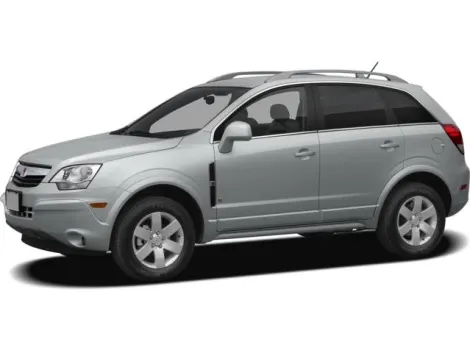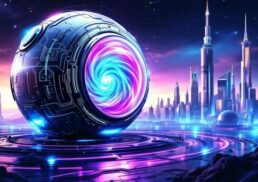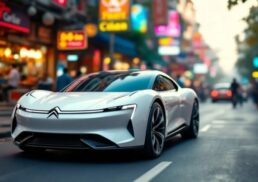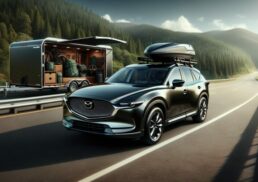Saturn Auto is known for its customer-focused cars and innovative designs. In this article, we explore the history, popular models, and unique features of Saturn cars.
Table of Contents
Key Takeaways
Saturn Corporation, a subsidiary of General Motors founded in 1985, was created to compete with Japanese imports by offering reliable and fuel-efficient cars with innovative features.
Popular Saturn models such as the S-Series, Vue, and Aura contributed to the brand’s appeal due to their fuel efficiency, hybrid options, and safety features.
Saturn’s unique selling points included dent-resistant polymer exterior body panels and a ‘no-haggle’ sales technique, which eliminated price negotiation and enhanced customer satisfaction.
Overview of Saturn Auto
The Saturn story began in mid-1982, and by January 7, 1985, Saturn Corporation was officially founded as a subsidiary of General Motors. Conceived to compete with the influx of Japanese imports, Saturn aimed to revolutionize the U.S. compact car market with its innovative approach and customer-focused philosophy. The first Saturn cars rolled off the production line in July 1990, symbolizing the brand’s commitment to quality and performance.
Saturn’s first assembly plant was strategically located in Spring Hill, Tennessee, to foster innovation and efficiency. This location became a hub of activity as Saturn began producing vehicles that would soon become household names. The company’s mission was clear: to provide reliable, fuel-efficient cars that could stand toe-to-toe with the best imports from Japan.
Despite its initial success and high customer satisfaction, Saturn’s journey was not without challenges. In 2009, amid economic turmoil, General Motors announced plans to sell or close the Saturn brand. A potential acquisition by Penske Automotive Group fell through, leading to the cessation of Saturn production in October 2009 and the closure of all Saturn dealerships by October 2010. Yet, the impact Saturn had on the automotive industry continues to be felt today.
Popular Saturn Models

Among the various vehicle models produced by Saturn, three stand out as particularly popular and influential: the Saturn S-Series, the Saturn Vue, and the Saturn Aura. Each of these models brought something unique to the table, from fuel efficiency and innovative features to hybrid options and advanced safety.
We will explore the distinctive characteristics of each of the red line models to appreciate their popularity among Saturn aficionados.
Saturn S-Series
The Saturn S-Series, produced from 1990 to 2002, was a compact saturn car designed with urban commuters in mind. Built on the same Z body platform as the GM Z platform, the S-Series was known for its fuel efficiency and practicality. Available in various body styles, including sedan (SL), coupe (SC), and station wagon (SW), the S-Series catered to a wide range of preferences and needs.
Under the hood, the S-Series offered different engine options to suit diverse driving styles. The Single Overhead Cam (SOHC) engines provided 85 to 100 horsepower, making them ideal for everyday driving. For those seeking more power, the Dual Overhead Cam (DOHC) engines delivered 124 horsepower and were featured in higher-end models like the SC2, SL2, and SW2. This versatility and performance made the S-Series a standout in the compact car segment.
Saturn Vue
Introduced in 2002, the Saturn Vue marked the company’s entry into the SUV market. This model quickly gained popularity due to its blend of performance, practicality, and innovative features. One of the most notable variations of the Vue was the Green Line hybrid version, launched in 2007. As one of the first compact SUVs to offer a hybrid option, the Vue Green Line provided an environmentally friendly alternative without compromising on performance.
The 2009 Saturn Vue offered a range of engine options, including a standard 4-cylinder engine in the XE version and a more powerful 6-cylinder engine in the XR and Red Line versions. This flexibility allowed buyers to choose a vehicle that matched their performance needs, whether they were looking for fuel efficiency or a more robust driving experience.
Saturn Aura
Launched in 2007, the Saturn Aura was praised for its European-inspired design and refined interior. This midsize car stood out in the Saturn lineup for its luxurious feel and advanced features. The Aura’s interior boasted high-quality materials, providing a more upscale experience compared to other Saturn models.
Safety was a key focus for only the Aura, which featured advanced safety systems and received high safety ratings from various organizations. The 2009 Aura offered both 4-cylinder and 6-cylinder engine options, catering to different performance preferences. Its commendable safety record and refined ride quality culminated in the Aura being awarded the 2007 North American Car of the Year.
Unique Features of Saturn Vehicles
Saturn vehicles were renowned for their unique features, setting them apart in the competitive automotive market. One of the most distinctive characteristics was the use of dent-resistant polymer exterior body panels. These plastic body panels, mounted on a steel space frame, were designed to withstand minor bumps and scrapes, reducing the need for costly repairs. Additionally, the polymer panels were rustproof, adding to the durability and longevity of Saturn cars.
Another groundbreaking aspect of Saturn’s approach was its ‘no-haggle’ sales technique, which also included offering a limited trade in value. By setting fixed prices for their cars, Saturn eliminated the stress and uncertainty often associated with car buying. This transparent pricing model was a significant departure from traditional car sales practices and led to higher customer satisfaction.
Saturn’s commitment to a straightforward and stress-free buying experience was part of its broader strategy to market itself as a ‘different kind of car company’. This philosophy resonated with consumers who valued a low-pressure sales environment and appreciated the innovative features that Saturn vehicles offered.
Performance and Engine Options
Saturn distinguished itself with a wide range of performance and engine options across its model spectrum. The S-Series, for instance, featured both Single Overhead Cam (SOHC) and dual overhead cam engines to cater to different performance needs. This flexibility allowed drivers to choose the same engine or engines that balanced power and efficiency according to their preferences.
In addition to traditional engine options, Saturn also ventured into hybrid technology with the Aura and Vue models. The 2009 Saturn Outlook, available with 6-cylinder engines in both XE and XR versions, showcased Saturn’s commitment to delivering optimized performance across its vehicle range. Similarly, the 2008 Saturn Sky offered a standard 4-cylinder engine and a higher-performance variant in the Red Line version, giving enthusiasts a taste of sporty driving.
Safety and Reliability
The cornerstones of Saturn’s allure, especially for families, were undoubtedly safety and reliability. The Saturn Aura, for example, received high safety ratings and was praised for its advanced safety features. These attributes made Saturn vehicles a preferred choice for those prioritizing safety in their automotive decisions.
Beyond safety, Saturn vehicles were generally reliable, provided they received regular maintenance. Non-dealer mechanics and repair shops found most Saturn models straightforward to service, ensuring that owners could keep their cars running smoothly without significant issues. This blend of safety and reliability contributed to Saturn’s strong reputation among car buyers.
The Rise and Fall of Saturn Corporation
The journey of Saturn Corporation, from its innovative successes to its eventual decline, is a captivating narrative. Here are some key milestones in the history of Saturn:
Founded on January 7, 1985, as a subsidiary of General Motors
Created to compete with Japanese imports in the U.S. compact car market
The first Saturn cars were produced in July 1990, marking the beginning of a new era in automotive manufacturing
Saturn’s innovative spirit was evident in initiatives like the introduction of the GM EV1 in 1996, the first electric car released under the GM brand. The company reached its peak in 1994, with annual sales hitting 286,003 vehicles. However, the economic downturn and strategic missteps led to GM’s decision to sell or close the Saturn brand in 2009.
An attempted acquisition by Penske Automotive Group in 2009 ultimately failed, leading to the end of Saturn production in October 2009 and the closure of all Saturn LLC dealerships by October 2010. Despite its closure, Saturn’s legacy of innovation and customer-centric approaches continues to influence the automotive industry.
Buying a Used Saturn
Understanding the maintenance history of a used Saturn is a vital factor to consider before making a purchase. Saturns are known for their robustness and ability to handle extensive driving, but regular maintenance, such as oil changes and sensor replacements, is essential to keep them reliable. The reliability of a used Saturn largely depends on how well it has been maintained by its previous owner.
Certain models, such as the Saturn Ion or Vue with CVT transmissions, are known for their unreliability even after repairs. It’s advisable to avoid the Saturn L-Series and 2002-2003 Saturn Vue with the V6 engine due to the high cost and complexity of engine repairs. Potential buyers should be cautious and consider these factors when selecting a used Saturn.
Despite some potential issues, many Saturn models still offer impressive fuel efficiency and may have valid warranty protection. With careful selection and regular maintenance, a used Saturn can be a reliable and cost-effective choice for many drivers.
Saturn’s Legacy in the Automotive Industry
Saturn’s indelible mark on the automotive industry can be attributed to its steadfast commitment to customer satisfaction and pioneering business practices. The key factors that set Saturn apart from its competitors include:
High customer satisfaction at Saturn dealerships, which set a new benchmark in the industry
Emphasis on transparent pricing and a hassle-free transaction process
Commitment to providing an incredible customer experience
These factors combined to make Saturn a leader in the automotive industry, alongside japanese auto manufacturers.
The lessons learned from Saturn’s unique business model continue to serve as a reference point for the automotive industry, highlighting the value of customer-centric strategies. Saturn’s story underscores the importance of mutual trust, respect, and dignity in both customer relations and employee culture, leaving a lasting impact on the industry.
Learn more, visit Saturn Cars: Everything You Need To Know.
Summary
In summary, Saturn Auto’s journey from its innovative beginnings to its eventual closure is a testament to the brand’s significant impact on the automotive industry. From the popular S-Series, Vue, and Aura models to the unique features and customer-focused business practices, Saturn set new standards in car manufacturing and sales. Although the brand is no longer in production, its legacy of innovation, transparency, and customer satisfaction continues to influence the industry. Saturn’s story reminds us of the importance of staying true to core values while adapting to changing market dynamics.
Frequently Asked Questions
What made Saturn vehicles unique?
Saturn vehicles were unique due to their dent-resistant polymer exterior panels, innovative manufacturing techniques, and a ‘no-haggle’ sales approach. This set them apart in the automotive industry.
Which Saturn models were most popular?
The most popular Saturn models were the S-Series, Vue, and Aura, each with unique features and performance options.
What engine options were available in Saturn vehicles?
Saturn vehicles had a variety of engine options, such as SOHC and DOHC engines in the S-Series, and hybrid variants in the Aura and Vue.
Why did Saturn Corporation cease operations?
Saturn Corporation ceased operations due to a failed acquisition attempt by Penske Automotive Group in 2009, which ultimately led to the end of production and closure of dealerships by 2010.
Is buying a used Saturn a good idea?
Yes, buying a used Saturn can be a good idea if the vehicle has been well-maintained and if you understand the common issues associated with it. Regular maintenance is crucial for reliability.









